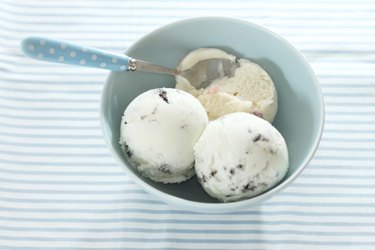
While you may be a fan of spicy food, accidentally biting into a Thai chili is certainly no fun. Your take-out order may leave you panicked and rushing to neutralize capsaicin's effects with a glass of water. However, you may find more relief from a glass of milk instead.
What Is Capsaicin?
Video of the Day
Different chili peppers belonging to the Capsicum genus contain varying amounts of heat, thanks to an essential alkaloid compound called capsaicinoid. A May 2014 study published in Molecules explain that capsaicin, along with dihydrocapsaicin, are the two major components of capsaicinoids. These compounds are responsible for the various spice levels an individual experiences when eating different chilies.
Video of the Day
According to Colorado State University Food Source Information, capsaicin is typically produced by the capsaicin glands that are located between the pepper's placenta and the endocarp region. Capsaicin is concentrated closest to the seeds of the chili pepper, so in order to neutralize capsaicin effect in foods, you should avoid adding seeds and the tissues which surround them to your dishes.
Read more: Foods to Avoid If You Have Gastroenteritis
The intensity of capsaicin, and its spice effects, depend on the chili pepper in questions. The Institute of Food & Agricultural Services at the University of Florida explains that this intensity can officially be measured by the Scoville Heat Units (SHU) scale, which was originally developed by Wilbur Scoville. It is not necessary to neutralize capsaicin in red and yellow bell peppers, as they do not contain any capsaicin or provide any heat.
Jalapeno peppers, however, contain anywhere from 2,000 to 8,000 SHU, and so it will be necessary to neutralize jalapeños if the spice levels are too high for an individual. Thai chilis are even hotter, measuring anywhere from 50,000 to 100,000 units on the Scoville scale.
In addition to having greater amounts of capsaicin, as compared to their milder counterparts, hotter peppers also have a higher antioxidant level, explain the researchers from the May 2014 study in Molecules. The pepper's high capsaicin load can also offer analgesic and anti-inflammatory effects, along with cooling effects when capsaicin creams and ointments are applied externally.
How to Neutralize Capsaicin
According to Frostburg State University, capsaicin is soluble in alcohols and fats, but insoluble in water. This is one of the main reasons why drinking water to neutralize jalapeno or neutralize capsaicin will not have the desired calming effect. Milk and milk products like cheese, on the other hand, fare better for neutralizing jalapeno capsaicin.
Read more: Can Spicy Foods or Caffeine Cause Gastritis?
A July 2017 review published in Topics in Current Chemistry explains that casein, an important milk protein, is often used to increase the bioavailability of vitamin D. More important, it is the lipophilic nature of casein that causes it to surround the capsaicin compounds present in chili peppers. This neutralizes capsaicin by reducing the levels of heat an individual may feel when eating too much spicy food.
Chapman University's Schmid College of Science and Technology explains that since capsaicin also binds to ethanol, mild alcohol can also be consumed to cut the heat. A stronger beer with more than 4.2 percent alcohol content may help to quell and neutralize jalapeno pepper effects.
- Molecules: "Capsaicin and Dihydrocapsaicin Determination in Chili Pepper Genotypes Using Ultra-Fast Liquid Chromatography"
- Colorado State University: Food Source Information: “Jalapeño Peppers"
- University of Florida: Institute of Food & Agricultural Services: "Pick a Pepper"
- Frostburg State University: "Fire and Spice"
- Topics in Current Chemistry: "Potential of Casein as a Carrier for Biologically Active Agents"
- Chapman University: Schmid College of Science and Technology: "How to Literally Beat the Heat: The Secret to Why Wings Pair Well With Ranch and Beer”